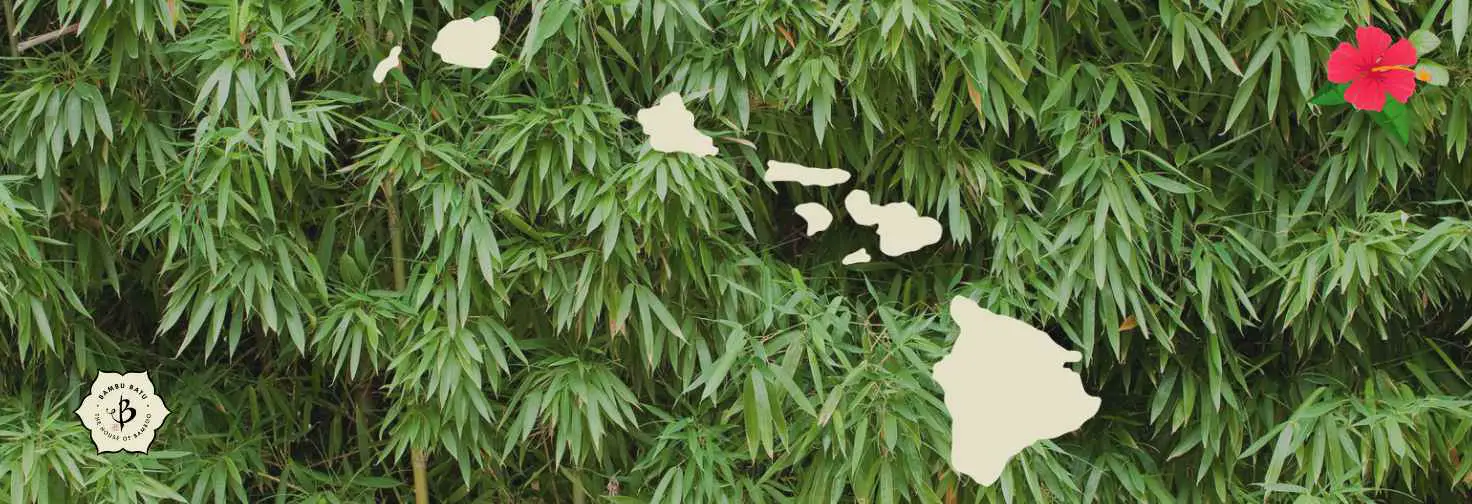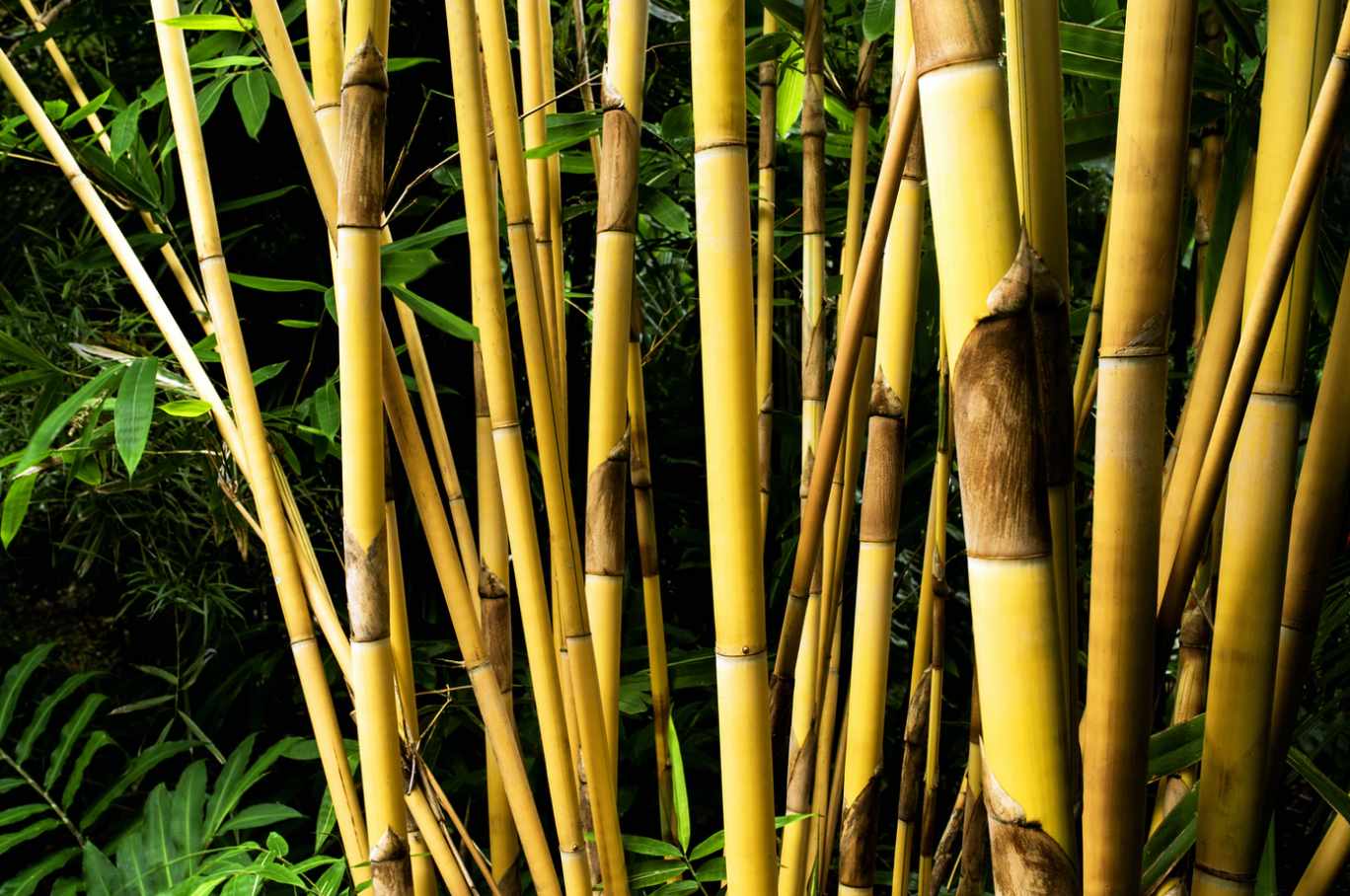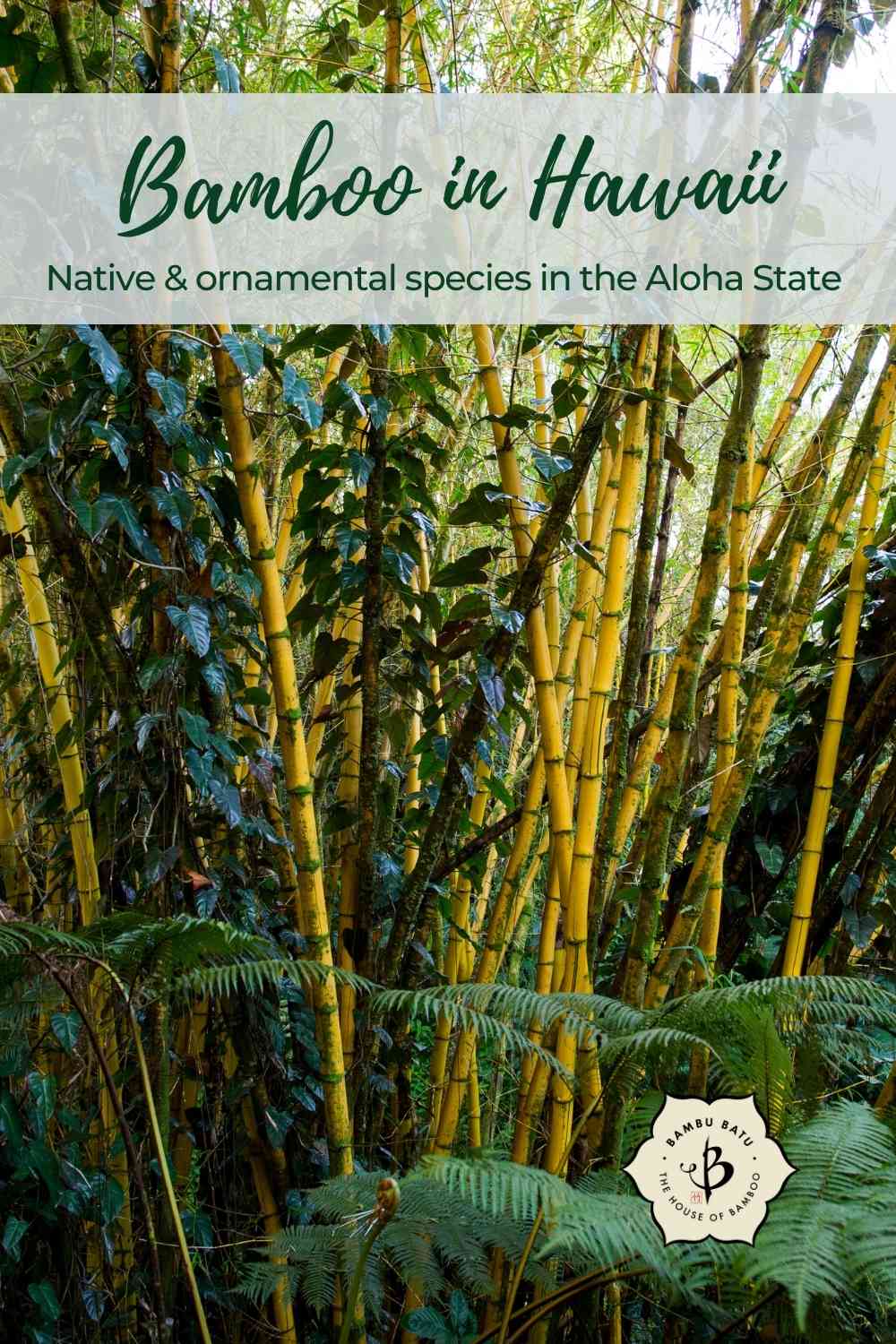Welcome to Hawaii, the Land of Aloha, with never-ending rainbows and drinks with little umbrellas as far as the eye can see. This tropical wonderland is something of a paradise for plant lovers, with growing conditions found nowhere else in the 50 states. Hawaii is home to vast varieties of orchids, bromeliads and heliconias, and has an excellent climate for growing bamboo.
Schizostachyum glaucifolium and Bambusa vulgaris are the two most prevalent species of bamboo growing on the islands of Hawaii. S. glaucifolium is also called Polynesian ʻohe, and B. vulgaris is more often known simply as common bamboo. But locals may refer to either of them as ‘ohe or Hawaiian bamboo. Though they both grow wild on the islands, which offer ideal conditions for bamboo, neither species is actually native to Hawaii.
A word about nomenclature and the ‘okina: The correct spelling of the 50th state is Hawaii, but the proper spelling in the native language is actually Hawai’i (with an apostrophe, or ‘okina, representing a glottal stop). Therefore, we should refer to the big island as Hawai’i, but the U.S. state as Hawaii. It’s slightly confusing, but not insurmountable. On the internet, however, the use of the ‘okina can create issues with search engines and certain typefaces. So we stick to the simplified spelling without the apostrophe, although we mean no disrespect to the indigenous Hawaiian culture. (Finally, “Hawaiian” is not actually a Hawaiian word, and so it needs no apostrophe.)
Is bamboo native in Hawaii?
No, bamboo is not actually native on the islands of Hawaii. Bamboo grows widely on this tropical archipelago, and unlike the hills of Africa, no one is surprised to find it growing here. And of course, the climate is ideal for many living things, including beachcombers and bamboo. But although bamboo has thrived in Hawaii for several hundred years, or more, it is not truly native.
Botanical and archeological evidence both indicate that humans, perhaps a thousand years ago, brought bamboo to the Hawaiian Islands from elsewhere in Polynesia or Southeast Asia. Botanists consider Schizostachyum glaucifolium a native of the Marquesas Islands and the Samoan Islands. But ancient Polynesians transported the bamboo westward to Hawaii and Tahiti because they recognized its great strength and utility for making crafts, tools and shelter. Today this bamboo covers hillsides on the southeastern part of Maui Island, especially in what is now the Haleakala National Park.
Bambusa vulgaris, a common species of Chinese bamboo, came to Hawaii much later. Modern explorers, either Asian or European, probably introduced it to the islands sometime in the early 1800s, after the arrival of Captain Cook in 1778. This robust species is cultivated for erosion control, as an ornamental and for building material.
Bringing bamboo to Hawaii
According to local myth and folklore, the Polynesian goddess Hina brought ‘ohe (bamboo) from Tahiti and covered the hills of Maui, in what is now the Haleakala National Park.
Today, you can bring bamboo to Hawaii without an act of god, but it is something strictly regulated. In order to protect the plush and pristine islands from the unintended consequences of invasive species, Hawaii’s Plant Industry Division has some pretty clear guidelines concerning importation, inspection, pests and quarantines.
Here are some of the main rules and regulations to be aware of:
- All plants require an inspection when entering Hawaii.
- Bamboo and other grasses require a permit and quarantine.
- Plants must be apparently free of insects and diseases.
- No soil allowed. Plants must be either bare-rooted or growing in something other than soil.
- Parcels and packages coming to Hawaii must be clearly labeled as “Plant Materials” or “Agricultural Commodities”.
- Shipments must include an invoice or packing manifest describing the contents and quantities of the plant commodities.
There are no laws to actually prohibit the cultivation of bamboo in Hawaii. The Invasive Species Council is more concerned with Arundo donax, a giant reed that resembles bamboo and is more invasive.

What varieties of bamboo grow in Hawaii?
Bambusa vulgaris: Also known simply as Common Bamboo, and sometimes called Golden Bamboo, this is one of the most widespread varieties in the world. Newcomers probably introduced this species to the islands in the early 19th century. This is a tropical, clumping bamboo native to China and southern Asia. Typically, the yellow culms of this bamboo can get 50-60 feet tall and 2-4 inches thick. The wood is strong, the culms walls are relatively thick, and the foliage is dense and attractive. But the poles are not perfectly straight, so it’s not ideal for building. B. vulgaris is a popular ornamental in warm climates, where it grows quickly and easily.
Schizostachyum glaucifolium: Commonly known as Polynesian ʻohe, this is one of the few bamboo species native to the South Pacific islands, namely Samoa and French Polynesia. Culms grow 40-50 feet tall and 2-3 inches thick. The poles are yellowish-green with long internodes. Although it’s not native to the islands, it has been naturalized to grow wild here. Because it has spread so successfully, it may look like a running bamboo, but Schizostachyum are clumpers. S. brachycladum, from southeast Asia, is a more popular ornamental species cultivated by gardeners.
Phyllostachys nigra: Black Bamboo, as it’s better known, has been reported on Maui, specifically on Wikimedia Commons. But this seems to be a misidentification. A temperate running bamboo from China, P. nigra is one of the most popular ornamental species of bamboo. Gardeners in Hawaii may grow this bamboo, but it does not grow in the wild. And as a running bamboo, you should be very careful about planting any Phyllostachys in a tropical habitat.
Ornamental bamboo in Hawaii
If you’re cultivating ornamental bamboo in Hawaii, you have plenty of fabulous options to choose from. Many of the giant tropical bamboos that won’t survive on the mainland will thrive in the Aloha State. Tropical varieties of Dendrocalamus, Gigantochloa, and Thyrsostachys, for example, will feel right at home here, and many smaller specimens as well. Check out the Quindembo Nursery to learn more (see below). And be aware of Hawaii’s strict regulations on imported plant life, as described above.

Where to find bamboo in Hawaii
The National Tropical Botanical Gardens of Allerton on the island of Kaua’i is a true tropical wonderland of fruit trees, heliconias and bamboo. It was formerly a sugar plantation and before that the dominion of a great Hawaiian Queen. Today they offer tours through an exquisitely designed garden and an unsurpassed botanical collection.
Waimea Arboretum and Botanical Gardens on the north shore of Oahu features 52 themed gardens and over 5,000 species of plants, including many native species unique to Hawaii. Alongside the towering groves of golden bamboo, you’ll discover a vast wealth of hibiscus, palms, tropical fruit trees, and exotic flowers.
Haleakala National Park takes its name from the massive volcano crater in the center of the park. In addition to this captivating crater, you’ll also find miles of hiking trails leading through verdant mountains and idyllic waterfalls. At the far eastern edge of the park, along Maui’s ocean coastline, the Pipiwai Trail takes you through an area called Kipahulu to the gorgeous Waimoku Falls. Along the way, you pass by what has to be the largest, thickest bamboo forest in all the 50 states, hillsides covered with Polynesian ʻohe.
Hawaiian bamboo nurseries
If you live in Hawaii and want to grow bamboo of your own, look no further than the Quindembo Bamboo Nursery in Kapaau, on the big island. They specialize in tropical, clumping, non-invasive bamboo, the kinds that grow so well here on the islands. These include various species of Bambusa, Dendrocalamus, Guadua and Schizostachyum, among others.
Their knowledgeable staff can help you choose between towering timber bamboos, compact specimen plants and ornamental hedges. Bamboo fits perfectly in the tropical landscape and the Aloha style, and knowing these are non-invasive varieties, you can’t go wrong. (And of course, Quindembo imports bamboo in strict accordance with Hawaii’s exotic flora regulations explained earlier in this article.)
On the island of Maui, Whispering Winds Bamboo provides a fine assortment of tropical, clumping bamboo species, as well as a small selection of bamboo poles and finished goods. They deliver on the island and ship products between islands.
Across the island from Honolulu, in Waialua, Oahu Bamboo has been providing tropical, clumping bamboo for hedges and specimen plants since 2019.
Further reading
If you found this article about bamboo in Hawaii interesting and informative, you might also enjoy these posts about bamboo cultivation and distribution.
- Where does bamboo come from?
- Introducing bamboo: Genus by Genus
- Clumping bamboo
- Tropical bamboo
- Bamboo in Africa
- Growing bamboo in Canada
- Bamboo in Colorado
FEATURED PHOTO: Forest of Schizostachyum glaucifolium along the Pipiwai Trail in the Haleakala National Park, on the island of Maui, Hawaii.



























Hi, do you know where I can buy bamboo in Oahu? The bamboos at the nurseries I found are very “thin” ones, not the thick stalk ones like the pictures you had as your profile. Those are the ones I’m looking for.
Whispering Winds on Maui offers inter-island shipping. If you’re buying a young bamboo plant in a pot, it will probably be pretty small. Once it goes in the ground and has a year or two to get established, it should begin to produce thicker poles, if it’s a timber bamboo variety. The nursery staff should be able to help you identify the species.
Oahu Bamboo has everything you need. Fantastic quality plants that will quickly reach their full scale.
http://www.oahubamboo.com/
Thanks for sharing!
Aloha.
We are a relatively new bamboo nursery based out of Waialua, Oahu. Would it be possible for you to add our website to your list of Bamboo Sources in Hawaii and link to our website? It would be very helpful for us. We have been around for about 2 years and are still in the process of getting out name out there. Thanks so much!
No problem. Keep up the great work!